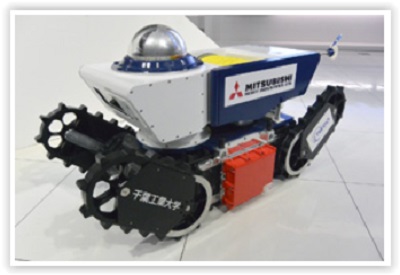|
|
|
|
|
|
| Contributing to Safe and Efficient Data Collection and Inspection in Tunnel Accidents and Petrochemical Plants |
TOKYO, July 12, 2016 - (JCN Newswire) - Mitsubishi Heavy Industries (MHI) and Chiba Institute of Technology (CIT) have jointly developed the remotely operated 'Sakura No. 2' (anti-explosive model) robot that features greatly reduced risk of electrical spark or heat creation that can cause explosions or fire when inflammable gas is present.
 | | Mitsubishi Heavy Industries, Ltd. and Chiba Institute of Technology have jointly developed the remotely operated "Sakura No. 2 (anti-explosive model)" robot that features greatly reduced risk of electrical spark or heat creation that can cause explosions or fire when inflammable gas is present. |
It is the first mobile robot in Japan that can be remotely operated either wirelessly or by wire to be officially certified as anti-explosive. Applications and demand will be developed for safe and efficient data collection, inspection and light work in environments that require equipment to be anti-explosive such as tunnel accidents and petrochemical plants.
The robot is based on the "Sakura No. 2" robot developed by CIT that has built up experience in applications such as accident resolution support activities in nuclear power plants, and the advanced anti-explosive design has been realized by utilizing MHI's broad technical capabilities in industrial fields. It received outsourcing support and assistance from the "Project to develop systems to handle the social challenges of infrastructure maintenance management and renewal"(1) of The New Energy and Industrial Technology Development Organization (NEDO).
It also passed the anti-explosive model inspection of the Technology Institution of Industrial Safety (TIIS) in Japan. Further, it is planned to obtain an anti-explosive certification based on the ATEX Directive that is widely adopted in Europe and around the world. In order to make the robot anti-explosive, the pressure resistant anti-explosive casing that houses components such as the lithium ion batteries and battery management system (BMS).
The casing for the electrical parts such as the motor and controller have a higher internal pressure than the external atmosphere, giving a two-fold internal pressure plus pressure resistant anti-explosive protection. Meaning, that inflammable gases cannot penetrate to the interior of the casing due to the pressure difference, and if the casing internal pressure drops, for example if the casing is damaged, this is detected and the power supply is cut off.
Since the batteries for storing electricity are protected by a pressure resistant anti-explosive casing that was jointly developed by IDEC Corporation, the risk of igniting gas due to electrical sparks or heat has been greatly reduced. Due to its advanced anti-explosive design the robot can operate in highly explosive and diffusible hydrogen gas, and can be used in zone 1 hazardous areas(2).
It is hoped that the robot can be used in many situations in addition to applications such as methane gas spouts during excavation and tunnel accidents with a high risk of ignition or explosion due to vehicle fuel leaks. In the future, the deterioration of much social infrastructure that was built after the high growth period and industrial infrastructure such as oil refining plants, chemical plants and power plants will accelerate, increasing the risk of damage to people and society.
Therefore, needs are growing for robots that can carry out investigations of abnormalities and perform light work for emergency inspections and rapid recovery at the time of disasters, as well as for preventing and limiting disasters. There is also a trend toward using robots in applications such as new oil field facilities or oil and chemical related facilities. The robots are expected to carry out work such as inspections at low cost and with high precision in places that are hard for humans to work in such as working at height or in confined areas.
In addition to making efforts to increase the needs from all sides on the occasion of the development of the Sakura No. 2 robot (anti-explosive model), MHI and CIT will strive to further expand applications and reveal potential needs, with initiatives such as developing an anti-explosive robot arm and a self-driving robot.
(1) The R&D theme "Project to develop systems to handle the social challenges of infrastructure maintenance management and renewal / Infrastructure maintenance management robot technology and non-destructive inspection equipment development / R&D of exploration robots for inflammable gas atmospheres" is a 4-year plan, of which FY2014 to FY2015 was an outsourced project and FY2016 to FY207 is a support project.
(2) Second of three hazardous area classifications: A place in which a hazardous atmosphere is likely to occur in normal operation. Applies to almost all hazardous places other than inside oil tanks (zone 0).
Contact:
Mitsubishi Heavy Industries, Ltd.
Joseph Hood, PR Manager
Email: mhi-pr@mhi.co.jp
Tel: +81-(0)3-6716-2168
Fax: +81-(0)3-6716-5860
Topic: Press release summary
Source: Mitsubishi Heavy Industries, Ltd.
Sectors: Design Process, Electronics, CyberSecurity
https://www.acnnewswire.com
From the Asia Corporate News Network
Copyright © 2024 ACN Newswire. All rights reserved. A division of Asia Corporate News Network.
|
|
|